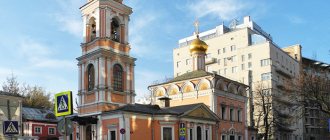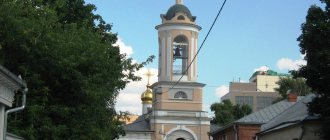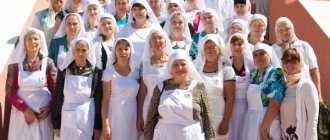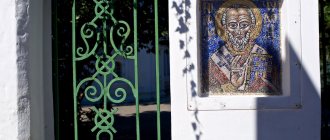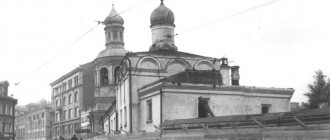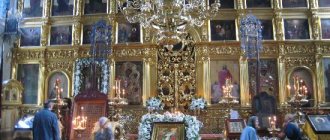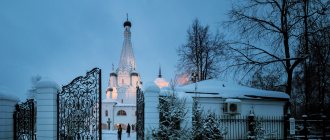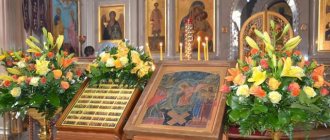History of construction
Bryusov Lane was built on the site of a ravine between Tverskaya and Nikitinskaya streets in the 16th century, near which the Assumption Church stood. The ravine and the Church of the Assumption of the Virgin Mary are long gone, but the name of the Assumption Enemy, the ancient site of the White City, remains.
Church of the Resurrection of the Word in Bryusov Lane
The background to the appearance of the Church of the Resurrection of the Word on Bryusov Lane is unique. The shrine of the church is the Church of the Resurrection of the Lord in Jerusalem, revived by the saints Emperor Constantine and his mother Helen in 355 at the site of Christ's crucifixion, on Mount Golgotha.
For more than three centuries, at the site of the suffering and crucifixion of Jesus, pagan worship was carried out in the temple of Venus, until, after the discovery of the Life-Giving Cross, an Orthodox temple was erected here.
The memory of this unique event is celebrated by the Orthodox Church on September 26; in many churches, including the Church of the Resurrection of the Word in Moscow, a patronal holiday is celebrated. The year 1548 contains the first mention of the wooden Church of the Renewal of the Church of the Resurrection of Christ.
Construction of a stone church
The fire of 1629 destroyed all buildings on the Uspensky Vrazhek, including the church.
A new stone church was erected in 1634, as evidenced by the petition of the rector Matthew to Patriarch Josaphat the First for consecration.
In 1634, after the abolition of the nearby church, the Eliseevsky throne appeared in the Church of the Resurrection of the Word, reconsecrated from the Pokrovsky throne.
The chapel of the prophet Elisha was built in memory of the time when Tsar Mikhail Fedorovich met his father, Patriarch Philaret, who returned after being captured by the Poles. Until 1812, the chapel existed as a separate temple.
Divine service in the Moscow Church of the Resurrection of the Word
By 1634, the Church of the Resurrection had three parishes:
- Eliseevsky;
- Martyrs Paraskeva;
- Nikolsky.
Records from 1638 were found that mention a monastery on the Uspensky Vrazhek, which suggests that monks’ cells once stood on Bryusov Lane.
At the beginning of the 18th century, the Moscow shrine was under the patronage of Prince M. Gagarin, whose funds were used to carry out repairs and replace the temple roof.
The plague of 1771 led to the death of all the priests, and a fire in 1773 destroyed the new roof. Until the beginning of the 19th century, the Christian monastery was closed, then it was gradually rebuilt.
In 1897, a huge bell was donated for the bell tower; to install it, the upper bell tiers had to be rebuilt, which gave the temple a more modern look.
Period of destruction
During the mass closure of Christian shrines at the beginning of the 20th century, services in the Church of the Resurrection of the Word did not stop for a day, thanks to the intercession and petition of famous people in Moscow and throughout the world living in nearby areas, only in the 30s of the 20th century were the bells removed and all valuables were taken.
Interesting! Among the parishioners of the church one could meet singers, actors, writers and other prominent personalities, among whom were Ivan Kozlovsky, Vladimir Zamansky, the Pirogov brothers, Konstantin Stanislavsky, Maria Maksakova and many others.
At Easter 1944, the temple grounds and nearby streets were filled with more than 2.5 thousand parishioners.
Whose intercession saved the temple?
There is hardly any unambiguous explanation for this fact, which was out of the ordinary for those years. Most often it is associated with the fact that many prominent figures of Soviet science, culture and art traditionally settled in Bryusov Lane, most of whom were loyal to religion. It was their intercession that helped save this outstanding monument of Russian temple architecture from destruction.
There is reason to believe that special merit in this noble cause belongs to the outstanding Russian director and actor - K. S. Stanislavsky, who also lived for many years not far from the Church of the Resurrection of the Word in Bryusov Lane (the portrait is shown above). His authority in government circles was so great that he often influenced the resolution of the most important issues. But this is the opinion of the city’s historians, while the majority of believers see the preservation of the temple as the intercession of the Heavenly Forces.
Current state
The services of Metropolitan Pitirim of Volokolamsk and Yuryev have nourished Orthodox believers for more than 40 years. In a special majestic, solemn atmosphere of holiness, through the prayers of the Metropolitan, God’s special love poured into the hearts of the parishioners, acquiring new children for the Orthodox Church.
The modern Church of the Resurrection of the Word in Bryusovsky Lane is a typical building for a street church, built in the classical style. The architectural features of the ancient Moscow shrine are decorative semicircular walls, window casings, pilasters, the presence of a cornice and a columnar belt.
Inside the Resurrection Church
Since 1820, the premises of the refectory and the bell tower, attached to the western side of the five-domed quadrangle, have been preserved. The stucco molding and picturesque ornament of the main vault appeared in 1880, the interior painting and iconostasis were done at the end of the 19th century.
The rector of the temple is Archpriest Nikolai Balashov. A Sunday school is open for parishioners, clubs operate, and joint pilgrimage trips are often made.
Construction of a stone church
At the same time, God-loving Muscovites began building a new, this time stone, church, work on which was completed five years later. Judging by the surviving historical documents, its appearance differed little from the Church of the Resurrection of the Word in Bryusov Lane that now exists and is known to most Muscovites.
Some changes to the appearance of the temple were made only in the first half of the 19th century, when a two-tier bell tower was built, which brought its appearance closer to the canons of the then fashionable architectural movement, called “Russian classicism.”
Shrines
Thousands of pilgrims come to Moscow to venerate the icons of the Church of the Resurrection of the Word.
The miraculous image of the Mother of God “Seeking the Lost” is hung with many decorations brought by grateful parishioners who received answers to prayers about problems:
- addiction to alcohol, drugs and computer games;
- loss of faith and confidence in life;
- family discord;
- healing from incurable diseases.
There are always crowds around the icons of the Mother of God “Znamenskaya”, “Bogolyubskaya”, “Quench My Sorrows”, “Iverskaya”, “Smolenskaya”, “Kazanskaya” and others.
The miraculous icon of St. Spyridon of Trimythous
A rare icon of St. Nicholas of Mozhaisky has been helping parishioners since the 16th century. They help strengthen faith and solve many problems and prayers from the holy images of the martyrs Saints Damian and Cosmas, George the Victorious, Saints Spyridon of Trimifuntsky, Savva of Storozhevsky and other shrines.
Address, telephone numbers and directions
Driving directions
from the site nakarte.ru:
Schedule
: daily — Liturgy at 8 o’clock, Vespers and Matins at 18 o’clock, on Sunday. and holiday — two Liturgies at 7 and 10 a.m., the day before — an all-night vigil at 6 p.m.
Telephone
: 290-57-01
Address
: per. Aksakova, 20
Directions
: M. "Arbatskaya", between Sivtsev Vrazhek lane and M. Afanasyevsky lane.
Nearest metro
:
- Metro "Arbatskaya"
Clergy:
The rector of the metochion is Archimandrite Theophylact (Georgiadis), the honorary rector is Archpriest. Vasily Serebryanikov, Rev. Vladimir Frolov, prot. Mikhail Krutin, Priest Evgeny Bataev, Priest Alexy Dubrovsky.
Attention!
Clergy membership and service schedule information may be out of date. If you have additional information about the composition of the clergy of the temple, about changes in the schedule of services, about the history of the temple, about upcoming and past events at the parish, about the shrines and icons of the temple, about travel options to the temple, etc., please provide them in the comments section.
Church of the Resurrection at Semenovskoye Cemetery
Story
Built in 1855 with one dome - in church symbolism this means Christ. At the same time, the bell tower looks like a second dome - and together they already mean the dual essence of Jesus - earthly and divine. In the year of construction, the temple was consecrated by Saint Philaret of Moscow (Drozdov) - this is the great-great-great-grandfather of our famous TV presenter Nikolai Drozdov (the same one from the program “In the Animal World”). The last rector, Pavel Anisimov, was shot in 1937 at the Butovo training ground.
The Church of the Resurrection at the Semenovskoye cemetery was built in 1855. Photo: Natalia ANDREASSEN
In 1929 it was closed and a mechanical repair plant moved into the temple. In 1935, they began to liquidate the huge Semenovskoye cemetery surrounding the temple, where military personnel had long been buried - in particular, heroes of the Patriotic War of 1812. The young poet of the Pushkin era, Alexander Polezhaev, was buried here, whom Nicholas II personally ordered to be a soldier for his free-thinking poetry. The cemetery was officially closed in 1931, and at the beginning of the war, students were sent here to dig a foundation pit for the construction of an aircraft factory. Later, a park was partially laid out on the site of the graves, and high-rise buildings were built on most of the former necropolis.
The temple is located on the territory of a former military cemetery. Photo: Natalia ANDREASSEN
In 2021, Patriarch Kirill called on believers to pray for those who were buried in this place and never call Semenovsky Church “in a former cemetery,” because “there are no former cemeteries.”
Shrines:
- Icon of the Blessed Matrona of Moscow with a particle of relics;
- Icon of the holy noble princes Peter and Fevronia of Murom wonderworkers with a particle of relics.
How to get there
Metro
metro station Semyonovskaya, Elektrozavodskaya, Izmailovskoe highway, 2.
Pilgrimage tours
For many, a trip to holy places is not just a journey, but a test of their spirit, a request for the secret and hope for a miracle.
Such excursions are especially in demand on major religious holidays, but take place throughout the year. We have collected options for pilgrimage trips for you - from one-day tours to extended routes. Find out more
Church of the Resurrection of Christ in Kadashi
Story
It is believed that if you draw a straight line from the bell tower of this temple in Zamoskvorechye, then one part of the line will rest against the bell tower of Ivan the Great. And the other - to the palace Church of the Ascension in Kolomenskoye, which was built in honor of the birth of the future Ivan the Terrible. In a word, the main urban axis of Moscow passes through the Kadashevskaya Church.
The church in Kadashi has been known since the 17th century. Photo: Natalia ANDREASSEN
The church in Kadashi (this name is because Kadashi lived in this area: coopers, barrel makers) has been known since the 17th century. Since then, it has been rebuilt several times, including restoration after the barbaric pogrom that the French carried out here in 1812. After its closure under the Soviet Union, the KGB archive, the sausage factory sports club, and the Grabar Art Research and Restoration Center were located here. While rescuing church relics in the 1920s, some girl carried out an ancient icon of the Vladimir Mother of God from the hem. And when the temple was returned to the believers in 2006, the daughter of that girl brought the icon back to the temple.
Some of the temple bells, after being destroyed in the 1930s, ended up in the Bolshoi Theater. Photo: Natalia ANDREASSEN
Yes, services in the church were revived quite recently, and before that the believers gathered in a small room of the former coach house and in the basement, digging it deeper. There they built a catacomb-type church of St. Job of Pochaev (in the Middle Ages - abbot of the Pochaev Lavra in Ukraine, second in importance after the Kiev-Pechersk Lavra). Skulls found during the destruction of other ancient burials were brought here - they are stored in two large coffins covered with glass. The guides point specifically to one of the skulls: it is believed that these are the remains of the pioneer printer Ivan Fedorov, whose burial was destroyed near Lvov.
Services in the church have been revived quite recently. Photo: Natalia ANDREASSEN
The temple, which recently survived the threat of demolition (in those expensive places in Zamoskvorechye in the early 2000s they wanted to build housing for moneybags), is still under restoration. Although services are going on here. But the temple just can’t wait for the return of its original bells: after the ruin in the 1930s, some of them ended up... in the Bolshoi Theater. And they say they still call in the opera “Boris Godunov”.
Shrines:
- Relics of the Optina elders.
- Pochaev Icon of the Mother of God.
- Tikhvin Icon of the Mother of God.
- Icon of St. Job, abbot of Pochaev.
How to get there
Metro
m. Tretyakovskaya, Novokuznetskaya, 2nd Kadashevsky lane, 7.
Architectural features of the temple
The building of the Church of the Resurrection of the Word on Uspensky Vrazhek, the design of which is based on a pillarless single-domed quadrangle, is a building very typical of church architecture of the 17th century. A characteristic feature of its walls are the zakomaras - the semicircular decorative endings crowning them. The general style of the era is complemented by vertical projections of the walls - corner pilasters decorated with half-columns.
The fact that the building was erected by an experienced and extraordinary master (whose name remains unknown) is evidenced by many details of the architectural decoration. One involuntarily attracts the eye to the modest, but at the same time, very skillfully executed window frames, the cornice running along the profile of the building, the dome drum and many other design elements of the temple in Bryusov Lane.
